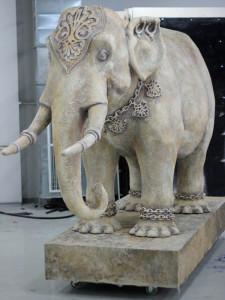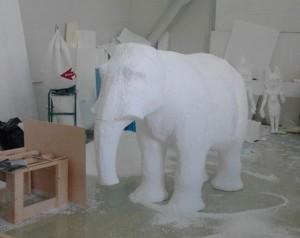 Any theatrical production requires a great deal of creativity from everyone involved – not just the actors and director, but the technicians and stage designers who have to work with an often limited amount of resources to manifest the director’s vision. I’ve worked in a lot of low-budget theatres, so I know firsthand that less money often correlates to more inventiveness. If my college theatre department taught me anything, it was how to repurpose things. We had a very small prop loft full of strange objects that had been reused, disassembled, reassembled, hacked, and painted over and over again for decades. Nothing was ever thrown out, because it was likely it would somehow be useful again someday. It looked like a hoarder’s lair, but that creepy little room turned out to be a gold mine for every production.
Any theatrical production requires a great deal of creativity from everyone involved – not just the actors and director, but the technicians and stage designers who have to work with an often limited amount of resources to manifest the director’s vision. I’ve worked in a lot of low-budget theatres, so I know firsthand that less money often correlates to more inventiveness. If my college theatre department taught me anything, it was how to repurpose things. We had a very small prop loft full of strange objects that had been reused, disassembled, reassembled, hacked, and painted over and over again for decades. Nothing was ever thrown out, because it was likely it would somehow be useful again someday. It looked like a hoarder’s lair, but that creepy little room turned out to be a gold mine for every production.
Moscow’s Bolshoi Theatre obviously has a much larger budget and more resources than any theatre I’ve ever worked in, but even well-funded productions require a lot of resourcefulness. Earlier this year, the theatre put on a production of La Bayadère (The Temple Dancer), a ballet that tells the story of a tragic romance set in India. The opulent set required quite a few large, complex pieces, including a lifelike elephant. It couldn’t be life-sized, obviously, but it needed to be big enough to be seen clearly from the back of the theatre, so the set designers settled on a 5-foot-tall statue.

 To build something this big, the designers started small. A sculptor created a small clay figure of the elephant, which was scanned using a RangeVision 3D scanner. The scan was converted into a CAD model and scaled up to 20 times its original size. The CAD model was then uploaded to a CNC foam carving machine, which cut the 150 cm high elephant from a large block of lightweight foam material. The elephant was then coated, painted, and intricately decorated before taking its place onstage.
To build something this big, the designers started small. A sculptor created a small clay figure of the elephant, which was scanned using a RangeVision 3D scanner. The scan was converted into a CAD model and scaled up to 20 times its original size. The CAD model was then uploaded to a CNC foam carving machine, which cut the 150 cm high elephant from a large block of lightweight foam material. The elephant was then coated, painted, and intricately decorated before taking its place onstage.
Anyone looking at the finished elephant would easily assume that it had been carved out of stone, but the foam material allowed for the elephant to be deceptively lightweight. Moreover, its construction, thanks to the 3D scanner and CNC machine, was a breeze, requiring very little time or money. The Bolshoi theatre has been creating a lot of its props and set pieces using this method.
“Scanning takes about 6 minutes and as a result we get an accurate and highly detailed 3D model in colour,” said scene decorator Ivan Petrov. “Such model can be stored for years, you don’t need any space for it, which is important, when you have limited storage facilities. What’s more, unlike clay or other materials, it is resistant to negative effects of atmosphere and time.”
I’m trying to imagine how my college theatre days would have been different if we had had a 3D scanner. Rather than a cramped, allegedly haunted room packed with physical objects, a digital library of 3D scanned props would have made things much easier to store, catalog and modify if necessary. Although, if I’m honest with myself, it probably wouldn’t have been nearly as much fun. Discuss this story in the 3D Scanning a Giant Elephant forum on 3DPB.com.
Subscribe to Our Email Newsletter
Stay up-to-date on all the latest news from the 3D printing industry and receive information and offers from third party vendors.
You May Also Like
Profiling a Construction 3D Printing Pioneer: US Army Corps of Engineers’ Megan Kreiger
The world of construction 3D printing is still so new that the true experts can probably be counted on two hands. Among them is Megan Kreiger, Portfolio Manager of Additive...
US Army Corps of Engineers Taps Lincoln Electric & Eaton for Largest 3D Printed US Civil Works Part
The Soo Locks sit on the US-Canadian border, enabling maritime travel between Lake Superior and Lake Huron, from which ships can reach the rest of the Great Lakes. Crafts carrying...
Construction 3D Printing CEO Reflects on Being Female in Construction
Natalie Wadley, CEO of ChangeMaker3D, could hear the words of her daughter sitting next to her resounding in her head. “Mum, MUM, you’ve won!” Wadley had just won the prestigious...
1Print to Commercialize 3D Printed Coastal Resilience Solutions
1Print, a company that specializes in deploying additive construction (AC) for infrastructure projects, has entered an agreement with the University of Miami (UM) to accelerate commercialization of the SEAHIVE shoreline...





























